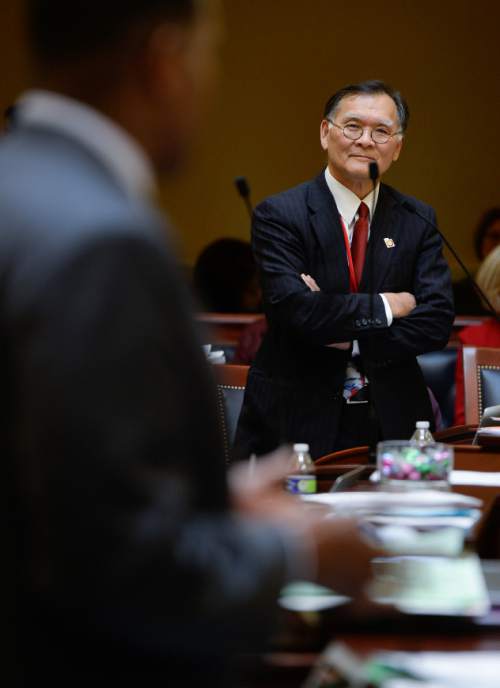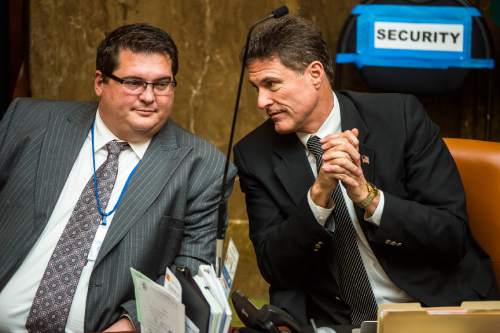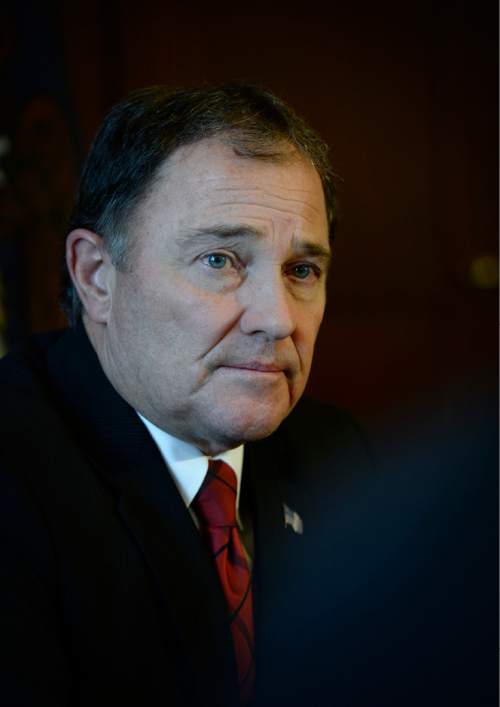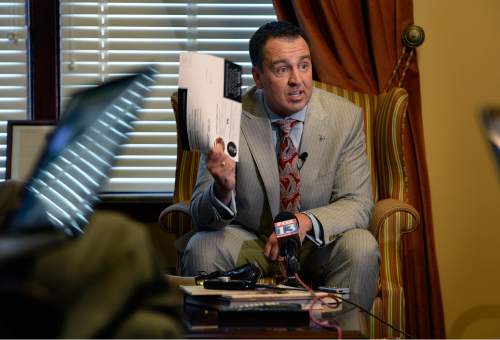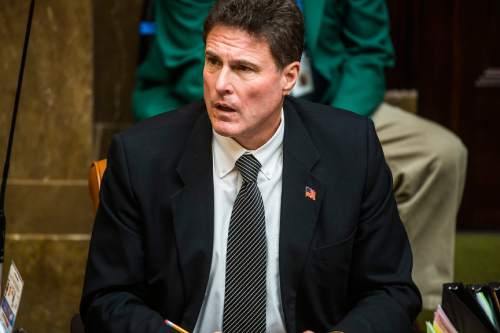This is an archived article that was published on sltrib.com in 2015, and information in the article may be outdated. It is provided only for personal research purposes and may not be reprinted.
Utah House leaders are quietly making a counteroffer on expanding Medicaid coverage for the poor, after earlier this week declaring dead on arrival the Senate-passed Healthy Utah plan pushed by Gov. Gary Herbert.
House Majority Leader Jim Dunnigan, R-Taylorsville, offered a few details to the press Friday, saying it is a middle-ground plan that covers fewer people and costs less than Healthy Utah, but covers more than some other stripped-down proposals.
Dunnigan says his proposal would cover about 60,000 Utahns in its first two years. Healthy Utah would cover an estimated 89,000 in the first year and 126,500 in the second.
A plan covering only the medically frail poor would reach about 10,000 residents, while some lawmakers want no Medicaid expansion at all.
"It provides coverage to all the people in the 'coverage gap' at a cost we can sustain," Dunnigan said of his plan. The coverage gap includes adults without children living below the poverty line who do not now qualify for Medicaid, but earn too little to qualify for subsidized health insurance under the Affordable Care Act.
He said while Healthy Utah is proposed as a two-year pilot plan, his proposal is for a sustainable, ongoing plan that could continue indefinitely and be affordable.
After two years — when President Barack Obama leaves office — Utah officials could approach the new administration to see if it would offer enhanced federal matches for the plan to make it even more affordable.
"If the feds say no at that time to an enhanced match," Dunnigan said, "we've got a program we can keep indefinitely" if lawmakers choose to do so. Dunnigan said the plan would cost roughly $65 million in the first two years. The governor's Healthy Utah 2.0 plan would cost $25 million, a smaller price tag because the federal government would cover most of the early costs. If it were a longer program, as originally proposed, Healthy Utah would be more expensive after 2020.
Dunnigan offered few other details of his proposal, saying it is still fluid as he discusses it with other leaders. He said he has talked to the lieutenant governor, the director of the Department of Health and "some senators."
Marty Carpenter, the governor's spokesman, responded in a prepared statement Friday evening, saying he has been provided a "conceptual outline" of Dunnigan's plan.
"From what we can see so far, the House proposal appears to cost $75 million over the same period and leaves 61,000 people in the gap without adequate coverage. Clearly that would be of concern to the governor."
Carpenter said that while Herbert is willing to work with the Legislature to come up with the best health-care plan, "the governor still firmly believes the House should give Healthy Utah 2.0 fair and open consideration. Likewise, Governor Herbert will give Representative Dunnigan's proposal due consideration."
Senate Majority Leader Ralph Okerlund, R-Monroe, said leaders on his side of the Capitol have heard few details about what the House wants, and have received no formal presentations about it.
Sen. Brian Shiozawa, R-Cottonwood Heights, who sponsored the Healthy Utah bill in the Senate, said senators continue to back it, even though House Speaker Greg Hughes, R-Draper, has declared it dead, saying it lacks enough support to pass there.
"Healthy Utah is so much better than the other plans out there. That's why we put it forth from the Senate," said Shiozawa, a physician. "It's a well-thought-out, well-designed and well-reasoned plan."
But he said the Senate is willing to negotiate and, at some point, "We have to ask ourselves a question … is something possibly better than nothing?"
On Friday, Hughes again defended his stance not to allow Healthy Utah to have House hearings or an up-or-down vote. He said House members told him they do not support the legislation, so it isn't worth taking time away from other important issues pending before the Legislature's March 12 adjournment.
"With days waning and time getting shorter," he said, "we can get together and get to something that's good."
Hughes said one reason he avoided allowing hearings on Healthy Utah is he wanted to prevent representatives from being targeted by the sort of direct-mail attacks that have been aimed at Dunnigan.
Mailers sent to residents in Dunnigan's district by the Alliance for a Better Utah said the Taylorsville Republican's plan "hurts Utah families." It compares his proposal to Healthy Utah — saying Dunnigan would cover 15,900 people in contrast to 146,000 covered by the governor's plan. It also said the scaled-back proposal "covers drug addicts, not families."
Hughes said he worried "false narratives trying to get a representative to vote in a certain way could work" by creating misguided pressure.
Hughes acknowledged using his own political-action committee to fund a mailer to defend Dunnigan.
That flier doesn't mention the governor or other groups supporting Healthy Utah. Instead, it praises Dunnigan for "leading the charge against federal intimidation" and "fighting the threats of Obamacare to ensure that we put Utah values first."
Meanwhile, Shiozawa said lawmakers should not be afraid of honest debate and pressure or questions from constituents.
"We were elected by our delegates, by our constituents, by our districts to come up here and serve," he said. "We knew what we were going into. We knew we would face scrutiny. We have a certain obligation and responsibility to be able to ask and answer questions and enter into debate on important issues."
Kristen Moulton contributed to this report.



